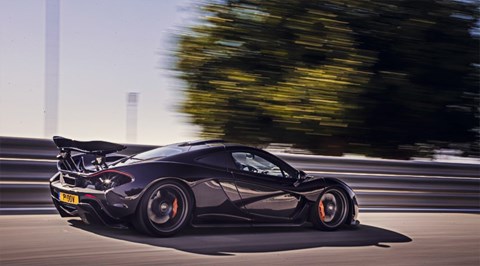► Next McLaren ‘Ultimate Series’ car
► Company’s ‘most extreme road car yet’
► Brutal looks, extraordinary aerodynamics
McLaren Automotive has confirmed its new ‘Ultimate Series’ model will be revealed on 10 December 2017. Arriving in summer 2018, the new car will give the P1 a run for its money as the Woking firm’s most intense road-legal model.
The next model to be introduced as part of the company’s ‘Track 22’ business plan, it’s described as ‘the most extreme, track-concentrated road car McLaren has yet designed.’
It’s not to be confused with the three-seater hypercar codenamed the BP23, also currently in development – that car, due late 2019, will have a more road-oriented, Grand Tourer ethos.
So far McLaren has issued two teaser pictures of the new Ultimate Series car, which can be viewed in this story’s gallery. The latest gives a glimpse of the car’s narrow tail-lights and integrated air outlets at its rear, while the earlier picture shows a triple exhaust layout. The perspective suggests the exhausts could be pointing upwards – channelling gases over an aerodynamic surface for downforce, maybe?
Ultimate Series designates McLaren’s fastest, most extreme road cars
McLaren currently divides its range into three tiers: the Sports Series (540C, 570S, 570GT), Super Series (720S) and Ultimate Series (the P1 – pictured below – and track-only P1 GTR, neither of which is still in production). The new car will re-ignite the top Ultimate tier in the company’s portfolio.

Although it will be an ‘ultimate track car’, McLaren says the new machine, codenamed P15, will be road-legal. It states, however, that ‘daily usability is being sacrificed to give the most intensive driver experience around a circuit.’ Probably a car better suited to the Nürburgring than to Knightsbridge, then.
McLaren describes the upcoming car’s design as ‘brutal’, and ‘the purest expression yet of the company’s “form follows function” philosophy.’ Expect a shape sculpted primarily by aerodynamics in that case, with as small a frontal area as possible and plenty of downforce-creating ducts and channels.
Debut early in 2018
McLaren says the new car will be publicly revealed in the first quarter of 2018 – that timing could coincide with the Geneva motor show, traditionally held in late February/early March.
While the P1 GTR was conceived as the flagship McLaren track car, the P15 is not a direct P1 replacement. For a start, it’s not expected to be a hybrid, but to use an uprated version of an existing McLaren V8 alone.
Company spokespeople suggest that a true P1 successor is unlikely to launch for some time, as it would require a step-change in technology in order to be significantly faster than the car it replaces. Ferrari has intimated something similar about a follow-up to the LaFerrari.
Although McLaren has built a pure EV prototype mule for its own internal testing, the P1 successor won’t be purely electric – despite it being at least five years from production.
Speaking to CAR’s editor-in-chief Phil McNamara at the 2017 Geneva motor show, McLaren CEO Mike Flewitt said:
‘Frankly I don’t see the next generation P1 being EV. We didn’t rule it out when we started on the journey but I don’t see it having the breadth of capability to be that car. I think that car is more likely to be a super-efficient hybrid in the kind of time frame that we’re talking about.’
Such is the rapid evolution of modern tyres, suspension, electronics and powertrain technology that the Porsche 918 Spyder – another member of the 2014 hybrid hypercar triumvirate – has been outpaced in terms of Nurburgring lap times by ‘conventional’, non-hybrid supercars such as the Lamborghini Huracan Performante and Porsche 911 GT2 RS.
The hypercar next wave
Mercedes-AMG’s Project One hypercar launches in 2019, featuring a hybrid powertrain derived directly from the firm’s recent F1 cars.
Aston Martin too is sprinkling a little F1 fairydust on its Valkyrie hypercar launching the same year, designed with help from Grand Prix design genius Adrian Newey and his Red Bull Racing team.
Ferrari traditionally has a gap of close to 10 years between its ultimate supercars – F40-F50-Enzo-LaFerrari – so will no doubt be hard at work behind the scenes but is unlikely to make anything public for a while yet.
Check back on 10 December for the full story on the next ultimate McLaren.
Video twin-test: McLaren P1 vs LaFerrari